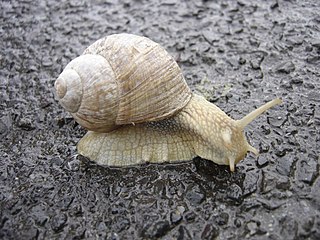
A snail is, in loose terms, a shelled gastropod. The name is most often applied to land snails, terrestrial pulmonate gastropod molluscs. However, the common name snail is also used for most of the members of the molluscan class Gastropoda that have a coiled shell that is large enough for the animal to retract completely into. When the word "snail" is used in this most general sense, it includes not just land snails but also numerous species of sea snails and freshwater snails. Gastropods that naturally lack a shell, or have only an internal shell, are mostly called slugs, and land snails that have only a very small shell are often called semi-slugs.

The gastropods, commonly known as snails and slugs, belong to a large taxonomic class of invertebrates within the phylum Mollusca called Gastropoda.

Trematoda is a class within the phylum Platyhelminthes. It includes two groups of parasitic flatworms, known as flukes.

Ampullariidae, common name the apple snails, is a family of large freshwater snails, aquatic gastropod mollusks with a gill and an operculum. This family is in the superfamily Ampullarioidea and is the type family of that superfamily.
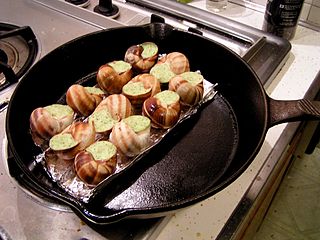
Escargot, from the French word for snail, is a dish consisting of cooked land snails. It is often served as an hors d'oeuvre and is common in France and India. Escargot is part of the typical cuisines of Cyprus, Malta, Crete, areas of mainland Greece, as well as the North African countries Tunisia, Algeria, and Morocco. Escargot is consumed in Germany, Great Britain, Italy, Portugal, and Spain.
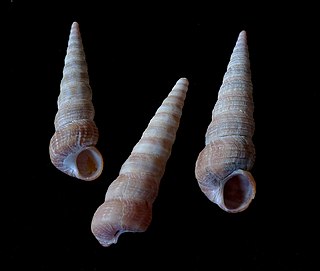
A spire is a part of the coiled shell of molluscs. The spire consists of all of the whorls except for the body whorl. Each spire whorl represents a rotation of 360°. A spire is part of the shell of a snail, a gastropod mollusc, a gastropod shell, and also the whorls of the shell in ammonites, which are fossil shelled cephalopods.

Cornu aspersum, known by the common name garden snail, is a species of land snail in the family Helicidae, which includes some of the most familiar land snails. Of all terrestrial molluscs, this species may well be the most widely known. It was classified under the name Helix aspersa for over two centuries, but the prevailing classification now places it in the genus Cornu.

Helix pomatia, common names the Roman snail, Burgundy snail, edible snail, or escargot, is a species of large, edible, air-breathing land snail, a pulmonate gastropod terrestrial mollusc in the family Helicidae. It is one of Europe's biggest species of land snail.

Lissachatina fulica is a species of large land snail that belongs in the subfamily Achatininae of the family Achatinidae.

The operculum is a corneous or calcareous anatomical structure like a trapdoor that exists in many groups of sea snails and freshwater snails, and also in a few groups of land snails; the structure is found in some marine and freshwater gastropods, and in a minority of terrestrial gastropods, including the families Helicinidae, Cyclophoridae, Aciculidae, Maizaniidae, Pomatiidae, etc.

Sea snail is a common name for slow-moving marine gastropod molluscs, usually with visible external shells, such as whelk or abalone. They share the taxonomic class Gastropoda with slugs, which are distinguished from snails primarily by the absence of a visible shell.

Cone snails, cone shells, or cones are a large group of small- to large-sized extremely venomous predatory sea snails, marine gastropod molluscs.

The umbilicus of a shell is the axially aligned, hollow cone-shaped space within the whorls of a coiled mollusc shell. The term umbilicus is often used in descriptions of gastropod shells, i.e. it is a feature present on the ventral side of many snail shells, including some species of sea snails, land snails, and freshwater snails.

The gastropod shell is part of the body of a gastropod or snail, a kind of mollusc. The shell is an exoskeleton, which protects from predators, mechanical damage, and dehydration, but also serves for muscle attachment and calcium storage. Some gastropods appear shell-less (slugs) but may have a remnant within the mantle, or the shell is reduced such that the body cannot be retracted within (semi-slug). Some snails also possess an operculum that seals the opening of the shell, known as the aperture, which provides further protection. The study of mollusc shells is known as conchology. The biological study of gastropods, and other molluscs in general, is malacology. Shell morphology terms vary by species group.

Euglandina rosea, common names the rosy wolfsnail or the cannibal snail, is a species of medium-sized to large predatory air-breathing land snail, a carnivorous terrestrial pulmonate gastropod mollusk in the family Spiraxidae.

A land snail is any of the numerous species of snail that live on land, as opposed to the sea snails and freshwater snails. Land snail is the common name for terrestrial gastropod mollusks that have shells. However, it is not always easy to say which species are terrestrial, because some are more or less amphibious between land and fresh water, and others are relatively amphibious between land and salt water.
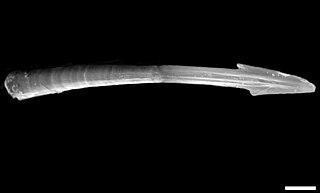
A love dart is a sharp, calcareous or chitinous dart which some hermaphroditic land snails and slugs create. Love darts are both formed and stored internally in a dart sac. These darts are made in sexually mature animals only, and are used as part of the sequence of events during courtship, before actual mating takes place. Darts are quite large compared to the size of the animal: in the case of the semi-slug genus Parmarion, the length of a dart can be up to one fifth that of the semi-slug's foot.
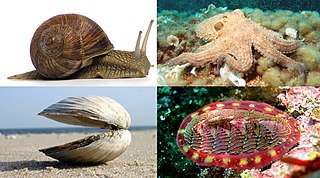
Mollusca is the second-largest phylum of invertebrate animals after the Arthropoda. The members are known as molluscs or mollusks. Around 85,000 extant species of molluscs are recognized. The number of fossil species is estimated between 60,000 and 100,000 additional species. The proportion of undescribed species is very high. Many taxa remain poorly studied.

Freshwater snails are gastropod mollusks which live in fresh water. There are many different families. They are found throughout the world in various habitats, ranging from ephemeral pools to the largest lakes, and from small seeps and springs to major rivers. The great majority of freshwater gastropods have a shell, with very few exceptions. Some groups of snails that live in freshwater respire using gills, whereas other groups need to reach the surface to breathe air. In addition, some are amphibious and have both gills and a lung. Most feed on algae, but many are detritivores and some are filter feeders.

Terrestrial molluscs or land molluscs (mollusks) are an ecological group that includes all molluscs that live on land in contrast to freshwater and marine molluscs.




















